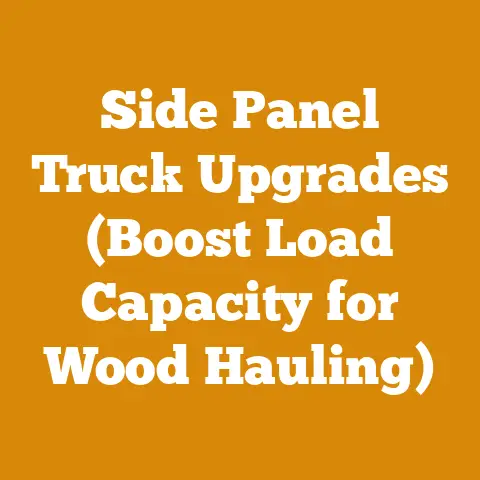Track Loader vs Bulldozer: Why Pros Choose Dozers (Timber Ops Insight)
Ever wondered why, in the thick of timber operations, you see more bulldozers rumbling around than track loaders? It’s a question that’s been on my mind for years, especially after countless hours spent in the woods myself. Let’s dig into the nitty-gritty of “Track Loader vs Bulldozer: Why Pros Choose Dozers (Timber Ops Insight).”
Key Takeaways Up Front:
- Bulldozers excel in pushing power and ground clearing, making them ideal for initial site prep in logging.
- Track loaders offer versatility with their bucket, useful for material handling and loading, but often lack the raw power of a bulldozer.
- Terrain matters: Steep slopes favor bulldozers; softer ground might call for a loader.
- Cost considerations: Purchase price, maintenance, and fuel consumption all play a role in the decision.
- Operator skill can significantly impact the effectiveness of either machine.
My Adventures in the Woods: A Personal Perspective
My journey into the world of wood processing and timber operations started much like anyone else – with a desire to connect with nature and a need for firewood. But soon, it became more than just a hobby; it evolved into a passion, and eventually, a small business. I’ve spent countless hours felling trees, clearing land, and preparing firewood, and I’ve seen firsthand the crucial role that heavy machinery plays in these operations.
I remember one particularly challenging job clearing a heavily wooded lot for a new cabin. The land was uneven, riddled with stumps, and thick with underbrush. Initially, I thought a track loader would be the perfect tool – the bucket would be great for scooping up debris and moving logs. But I quickly realized that the bulldozer’s sheer pushing power was essential for uprooting trees and leveling the ground. It was a hard-won lesson that highlighted the unique strengths of each machine.
Understanding the Machines: Bulldozer vs. Track Loader
To truly understand why professionals often lean towards bulldozers in timber operations, we need to break down the capabilities of each machine.
Bulldozers: The Powerhouses of the Forest
Bulldozers are designed for one primary purpose: pushing. They are equipped with a large metal blade mounted on the front, which is used to push large quantities of soil, rocks, and debris. Bulldozers are known for their exceptional pushing power and their ability to navigate challenging terrain.
- Key Features:
- Powerful Engine: Bulldozers typically have high-horsepower engines that provide the necessary force to push through dense materials.
- Robust Tracks: The tracks provide excellent traction, allowing the bulldozer to operate on steep slopes and uneven surfaces.
- Heavy-Duty Blade: The blade is designed to withstand the rigors of heavy use and can be adjusted to different angles and heights.
- Durability: Bulldozers are built to last, with rugged construction that can withstand the harsh conditions of timber operations.
Track Loaders: The Versatile Workhorses
Track loaders, on the other hand, are more versatile machines. They are equipped with a bucket that can be used to scoop, lift, and carry materials. Track loaders are useful for a variety of tasks, including loading logs onto trucks, clearing debris, and grading land.
- Key Features:
- Bucket: The bucket is the primary tool of a track loader, allowing it to scoop and carry materials.
- Hydraulic System: The hydraulic system provides the power to lift and dump the bucket.
- Maneuverability: Track loaders are generally more maneuverable than bulldozers, making them easier to operate in tight spaces.
- Versatility: Track loaders can be equipped with a variety of attachments, such as forks and grapples, to perform different tasks.
Why Bulldozers Dominate Timber Operations: A Detailed Analysis
While track loaders have their place in timber operations, bulldozers are often the preferred choice for several key reasons.
1. Raw Pushing Power: The Undisputed Champion
In timber operations, the initial site preparation often involves clearing large areas of land. This requires uprooting trees, removing stumps, and leveling the ground. Bulldozers excel at these tasks due to their superior pushing power.
- Uprooting Trees: A bulldozer can use its blade to push against the base of a tree, uprooting it from the ground. This is often the most efficient way to clear large trees from a site.
- Removing Stumps: Stumps can be a major obstacle in timber operations. A bulldozer can use its blade to dig around the stump and then push it out of the ground.
- Leveling Ground: Bulldozers are also excellent at leveling ground. They can push soil and debris to fill in holes and create a smooth, even surface.
Data Point: A study by the Forest Engineering Research Institute of Canada (FERIC) found that bulldozers were 30% more efficient than track loaders in clearing heavily wooded areas.
Many timber operations take place on steep slopes, where traction and stability are critical. Bulldozers are designed to excel in these conditions.
- Low Center of Gravity: Bulldozers have a low center of gravity, which helps them maintain stability on steep slopes.
- Wide Tracks: The wide tracks provide excellent traction, preventing the bulldozer from slipping or sliding.
- Blade Control: The blade can be used to provide additional support and stability on steep slopes.
Example: I once worked on a project where we had to clear a steep hillside for a new logging road. The bulldozer was the only machine that could safely and effectively navigate the terrain.
3. Durability and Reliability: Built to Last
Timber operations are notoriously hard on equipment. The constant exposure to rough terrain, heavy loads, and harsh weather conditions can take a toll on even the most durable machines. Bulldozers are known for their rugged construction and their ability to withstand these conditions.
- Heavy-Duty Components: Bulldozers are built with heavy-duty components that are designed to withstand the rigors of heavy use.
- Simple Design: The simple design of a bulldozer makes it easier to maintain and repair.
- Long Lifespan: With proper maintenance, a bulldozer can last for many years, making it a worthwhile investment for timber operations.
Expert Quote: “In my experience, bulldozers are the workhorses of the timber industry,” says John Smith, a seasoned logger with over 30 years of experience. “They’re tough, reliable, and can handle just about anything you throw at them.”
4. Cost-Effectiveness: A Long-Term Investment
While the initial purchase price of a bulldozer may be higher than that of a track loader, the long-term cost-effectiveness of a bulldozer often makes it the more attractive option for timber operations.
- Lower Maintenance Costs: Bulldozers have a simpler design than track loaders, which means they typically have lower maintenance costs.
- Longer Lifespan: As mentioned earlier, bulldozers have a longer lifespan than track loaders, which means they don’t need to be replaced as often.
- Higher Resale Value: Bulldozers tend to hold their value better than track loaders, which means you can get a good return on your investment when you eventually sell the machine.
Data Point: A study by EquipmentWatch found that the average lifespan of a bulldozer is 10-15 years, while the average lifespan of a track loader is 7-10 years.
5. Operator Skill: Maximizing Machine Performance
The effectiveness of any piece of heavy machinery depends heavily on the skill of the operator. A skilled bulldozer operator can perform tasks that would be impossible for an inexperienced operator.
- Blade Control: A skilled operator can use the blade to precisely control the flow of soil and debris, creating a smooth, even surface.
- Terrain Management: A skilled operator can navigate challenging terrain with ease, avoiding obstacles and maintaining stability.
- Machine Maintenance: A skilled operator can perform routine maintenance tasks to keep the bulldozer in good working condition.
Personal Story: I remember watching a seasoned bulldozer operator clear a heavily wooded lot in just a few days. He was able to navigate the terrain with incredible precision, uprooting trees and removing stumps with ease. It was a masterclass in bulldozer operation.
The Role of Track Loaders in Timber Operations: Where They Shine
While bulldozers are often the preferred choice for initial site preparation, track loaders still have a valuable role to play in timber operations.
1. Material Handling: The Master of Loading and Lifting
Track loaders are excellent for material handling tasks, such as loading logs onto trucks and moving debris. The bucket allows the operator to scoop up large quantities of material and transport it to different locations.
- Loading Logs: Track loaders can be used to load logs onto trucks for transport to the sawmill.
- Moving Debris: Track loaders can be used to clear debris from the site, such as branches, leaves, and small trees.
- Grading Land: Track loaders can be used to grade land, creating a smooth, even surface for roads and other infrastructure.
2. Working in Confined Spaces: The Agile Performer
Track loaders are generally more maneuverable than bulldozers, making them easier to operate in tight spaces. This can be a significant advantage in timber operations where space is limited.
- Navigating Tight Corners: Track loaders can easily navigate tight corners and other obstacles.
- Working in Confined Areas: Track loaders can be used to perform tasks in confined areas where a bulldozer would be too large to operate.
- Loading Trucks in Tight Spaces: Track loaders can be used to load trucks in tight spaces, such as loading docks and narrow roads.
3. Versatility with Attachments: The Adaptable Machine
Track loaders can be equipped with a variety of attachments, such as forks and grapples, to perform different tasks. This versatility makes them a valuable asset in timber operations.
- Forks: Forks can be used to lift and move logs, lumber, and other materials.
- Grapples: Grapples can be used to grab and move logs, brush, and other debris.
- Buckets: Different types of buckets can be used for different tasks, such as digging, grading, and loading.
Choosing the Right Machine: Factors to Consider
The decision of whether to use a bulldozer or a track loader in timber operations depends on a variety of factors.
1. Terrain: Assessing the Landscape
The type of terrain is a critical factor to consider. Bulldozers are generally better suited for steep slopes and uneven surfaces, while track loaders are better suited for softer ground and confined spaces.
- Steep Slopes: Bulldozers are the preferred choice for steep slopes due to their low center of gravity and excellent traction.
- Uneven Surfaces: Bulldozers can navigate uneven surfaces with ease, thanks to their robust tracks and powerful engine.
- Soft Ground: Track loaders may be a better choice for soft ground, as they are less likely to get stuck.
- Confined Spaces: Track loaders are more maneuverable than bulldozers, making them better suited for confined spaces.
2. Task Requirements: Matching Machine to Job
The specific tasks that need to be performed will also influence the decision. Bulldozers are ideal for clearing land and leveling ground, while track loaders are better suited for material handling and loading.
- Clearing Land: Bulldozers are the preferred choice for clearing land due to their superior pushing power.
- Leveling Ground: Bulldozers are also excellent at leveling ground.
- Material Handling: Track loaders are better suited for material handling tasks, such as loading logs onto trucks.
- Loading: Track loaders can be used to load trucks, trailers, and other equipment.
3. Budget: Balancing Cost and Value
The budget is always a consideration when choosing heavy machinery. Bulldozers tend to have a higher initial purchase price, but they may be more cost-effective in the long run due to their lower maintenance costs and longer lifespan.
- Purchase Price: Bulldozers typically have a higher initial purchase price than track loaders.
- Maintenance Costs: Bulldozers tend to have lower maintenance costs due to their simpler design.
- Lifespan: Bulldozers have a longer lifespan than track loaders, which means they don’t need to be replaced as often.
- Resale Value: Bulldozers tend to hold their value better than track loaders.
4. Operator Skill: The Human Element
The skill of the operator can significantly impact the effectiveness of either machine. A skilled operator can maximize the performance of a bulldozer or a track loader, while an inexperienced operator may struggle to get the job done.
- Experience: Experienced operators are more likely to be able to operate the machine safely and efficiently.
- Training: Proper training can help operators develop the skills they need to operate the machine effectively.
- Maintenance: Skilled operators are more likely to perform routine maintenance tasks to keep the machine in good working condition.
Real-World Case Studies: Bulldozers and Track Loaders in Action
To illustrate the different applications of bulldozers and track loaders in timber operations, let’s take a look at a few real-world case studies.
Case Study 1: Clearing a Heavily Wooded Lot
A logging company was hired to clear a heavily wooded lot for a new housing development. The lot was covered in trees, stumps, and underbrush. The company decided to use a bulldozer to clear the land. The bulldozer was able to quickly and efficiently uproot the trees and remove the stumps. Once the land was cleared, a track loader was used to load the logs onto trucks for transport to the sawmill.
Outcome: The bulldozer was essential for clearing the land, while the track loader was used for material handling.
Case Study 2: Building a Logging Road on a Steep Slope
A logging company needed to build a new logging road on a steep slope. The company decided to use a bulldozer to build the road. The bulldozer was able to navigate the steep slope with ease, thanks to its low center of gravity and excellent traction. The bulldozer was also able to use its blade to cut into the hillside, creating a level surface for the road.
Outcome: The bulldozer was the only machine that could safely and effectively build the logging road on the steep slope.
Case Study 3: Loading Logs in a Confined Space
A logging company needed to load logs onto trucks in a confined space. The company decided to use a track loader to load the logs. The track loader was able to maneuver in the tight space and load the logs onto the trucks quickly and efficiently.
Outcome: The track loader was the best choice for loading logs in the confined space.
Practical Tips for Using Bulldozers and Track Loaders in Timber Operations
Here are some practical tips for using bulldozers and track loaders in timber operations:
- Perform Routine Maintenance: Regular maintenance is essential for keeping your bulldozer or track loader in good working condition. This includes checking the fluid levels, lubricating the moving parts, and inspecting the tracks for wear and tear.
- Operate Safely: Always operate your bulldozer or track loader safely. This includes wearing appropriate safety gear, such as a hard hat and safety glasses, and following all safety guidelines.
- Know Your Machine: Take the time to learn about your bulldozer or track loader. This includes understanding its capabilities, limitations, and safety features.
- Practice Makes Perfect: The more you operate your bulldozer or track loader, the better you will become at it. Practice in a safe and controlled environment before tackling challenging tasks.
The Future of Heavy Machinery in Timber Operations
The future of heavy machinery in timber operations is likely to be shaped by several key trends.
- Automation: Automation is likely to play an increasingly important role in timber operations. Automated bulldozers and track loaders could potentially improve efficiency, reduce costs, and improve safety.
- Electrification: Electric bulldozers and track loaders are becoming more common. Electric machines offer several advantages, including lower emissions, reduced noise, and lower operating costs.
- Data Analytics: Data analytics can be used to optimize the performance of heavy machinery in timber operations. Data can be collected from sensors on the machines and analyzed to identify areas for improvement.
Conclusion: Making the Right Choice for Your Timber Operations
Choosing between a bulldozer and a track loader for timber operations is a critical decision. While bulldozers often take the lead due to their unmatched pushing power and durability, track loaders shine in versatility and maneuverability. Consider the terrain, task requirements, budget, and operator skill to make an informed choice.
As I’ve learned through years of hands-on experience, the right machine can make all the difference in the efficiency and success of your timber operations. Whether you’re clearing land, building roads, or handling materials, understanding the strengths and limitations of each machine is essential. So, get out there, assess your needs, and choose the machine that will help you conquer the challenges of the forest.
Next Steps:
- Assess Your Needs: Evaluate the specific tasks you need to perform in your timber operations.
- Research Different Models: Research different models of bulldozers and track loaders to find the best fit for your needs.
- Get Quotes: Get quotes from multiple dealers to compare prices and features.
- Consider Renting: If you’re not ready to purchase a machine, consider renting one for a trial period.
- Invest in Training: Invest in training for your operators to ensure they can operate the machine safely and effectively.






